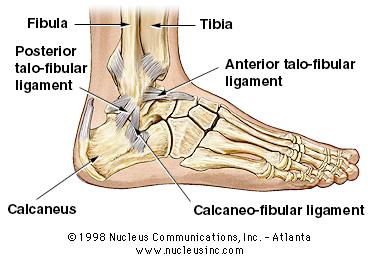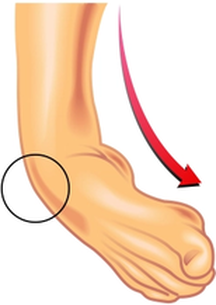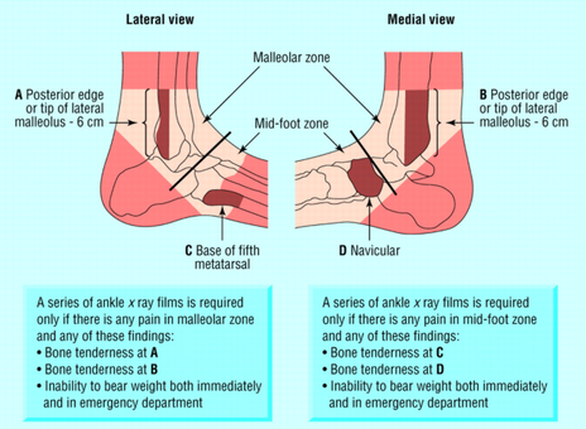
Ankle sprains are a very common injury, one of which many of us have experienced.
They make up approximately 20% of ALL sports injuries.
That being said, the overall incidence of lateral ankle sprains may be underestimated as ~50% of those who sustain an ankle sprain do not seek medical attention.
So that poses a question… did the 50% of people who didn’t seek medical advice do the right thing?
Maybe not.
Studies have shown that ankle sprains can be more serious than commonly believed as people can develop more long-standing (chronic) problems.
These problems include chronic ankle instability, chronic pain, and recurrent swelling.
Additionally, strong evidence suggests that after an ankle sprain, you are TWICE as likely to have another ankle sprain!
Repetitively injuring the same spot over and over can lead to significant long term problems.
Lateral Ankle Ligament Anatomy
Before we discuss the types of ankle sprains, we will review anatomy and a couple of terms.
You’ll remember from previous blog posts that we SPRAIN ligaments, and we STRAIN muscles.
So with ankle sprains, we’re talking about ligament injuries. Remember, ligaments are passive (we can’t control them) structures that connect two bones together.
Here’s a picture to help explain what I’m talking about:

As you can see, there are 3 main ligaments on the outside of the ankle: the anterior talofibular ligament (ATFL), the calcaneofibular ligament (CFL), and the posterior talofibular ligament (PTFL).
There are many other ligaments in the foot and ankle, as well as a plethora of muscles.
For simplicity sake (and because lateral (outside) ankle sprains are the most common), we will just worry about these ligaments in this blog post. When someone talks about spraining their ankle, they usually mean a lateral (outside) ankle sprain.
The ATFL is the weakest of the ligaments, and therefore the most commonly injured (70% of the time!).
Types of Ankle Sprains and Chronic Ankle Instability
A lateral ankle sprain usually occurs when the foot is forced into forefoot adduction, hindfoot inversion, and tibial external rotation with the ankle in plantar flexion.
Or, for those of you wanting me to speak English, this:

There are three grades of ankle sprains. Here’s a simple table to start to understand the grades of sprains:

* Remember to see a physiotherapist to get a complete evaluation and accurate diagnosis!
Simply put, Chronic Ankle Instability is when “feelings of giving way” or “feelings of instability” last for greater than 3 months after an ankle sprain.
In addition, some intermittent pain and swelling may occur.
The Ottawa Ankle Rules
After an ankle injury, many people may be concerned of a fracture, and wonder if they should get an x-ray.
Well, there’s a test for that! It’s called the Ottawa Ankle Rules, and it determines whether or not you should get an x-ray. Here are the Ottawa Ankle Rules:

Look at the image above carefully, because it fully explains the rules.
In short, if you have pain when you press on points A, B, C, or D, and you’re unable to walk 4 steps, then you should get an x-ray!
Note: these rules are very accurate, but their accuracy does decrease slightly when used on those under the age of 18.
Conclusion
It’s just an ankle sprain – do I really need physiotherapy? In 2019, an overview of systematic reviews with meta-analysis (science speak for the HIGHEST and BEST level of evidence) concluded that the treatment of ankle sprains should include:
- Early mobilization
- Exercise therapy, and
- Manual therapy
Further, they concluded that re-injury and chronic ankle instability can be prevented with:
- Neuromuscular training
- Exercise therapy, and
- Bracing
Physiotherapists are trained to provide education and treatment using the following:
- Early mobilization
- Exercise therapy
- Neuromuscular training
- Manual therapy, and
- Bracing
So, in short, YES! You should definitely get physiotherapy! A physiotherapist will tailor treatment individually to you, which will allow you to understand your type of injury, help you recover from your injury faster, and help you prevent re-injury!
Did you sprain your ankle, and need to have it properly assessed?
Are you interested in preventing chronic ankle instability? At Strive Physiotherapy & Performance, we are committed to providing an in-depth, one-on-one assessment to ensure we can work together to find the best plan of action for each individual client.
Call us at 519-895-2020, or use our online booking tool on www.strivept.ca to book an appointment with one of our knowledgeable physiotherapists, and they will be sure to help you understand your injury.
Take care,
Tyler Allen
Physiotherapist at Strive Physiotherapy and Performance
References:
1. Petersen, W., Rembitzki, I. V., Koppenburg, A. G., Ellermann, A., Liebau, C., Brüggemann, G. P., & Best, R. (2013). Treatment of acute ankle ligament injuries: a systematic review. Archives of orthopaedic and trauma surgery, 133(8), 1129-1141.
2. McGovern, R. P., & Martin, R. L. (2016). Managing ankle ligament sprains and tears: current opinion. Open access journal of sports medicine, 7, 33.
3. Doherty, C., Bleakley, C., Delahunt, E., & Holden, S. (2017). Treatment and prevention of acute and recurrent ankle sprain: an overview of systematic reviews with meta-analysis. Br J Sports Med, 51(2), 113-125.